
- This event has passed.
Read of the Week – Coney Island
April 29, 2020 @ 7:00 pm - 11:40 pm
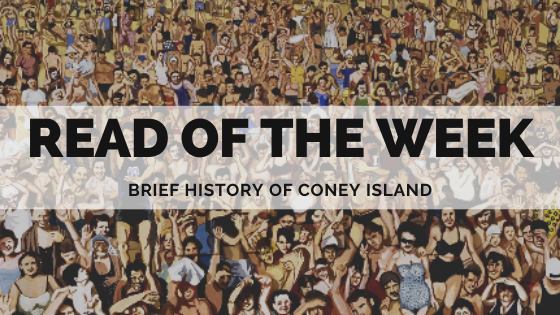
Coney Island on My Mind: A Brief History of Brooklyn’s Waterfront Playground

1930s Coney Island postcard. Image via Boston Public Library.
New York City starts in Coney Island.
When Henry Hudson came to our shores looking for a passage to the East in 1609, his first landing was at Coney Island. There he found the Canarsie people, who used the island as a place to fish, dig for mussels and clams, and hunt the rabbits called “coneys.” From there he sailed up New York Bay to Manhattan, and then up the river that now bears his name.
After realizing the river was not the route to China, he turned around and went home to his employers, the Dutch East India Company. They came back with farmers, trappers and merchants to colonize everything along Hudson’s route, including New Amsterdam, Breukelin and Albany.
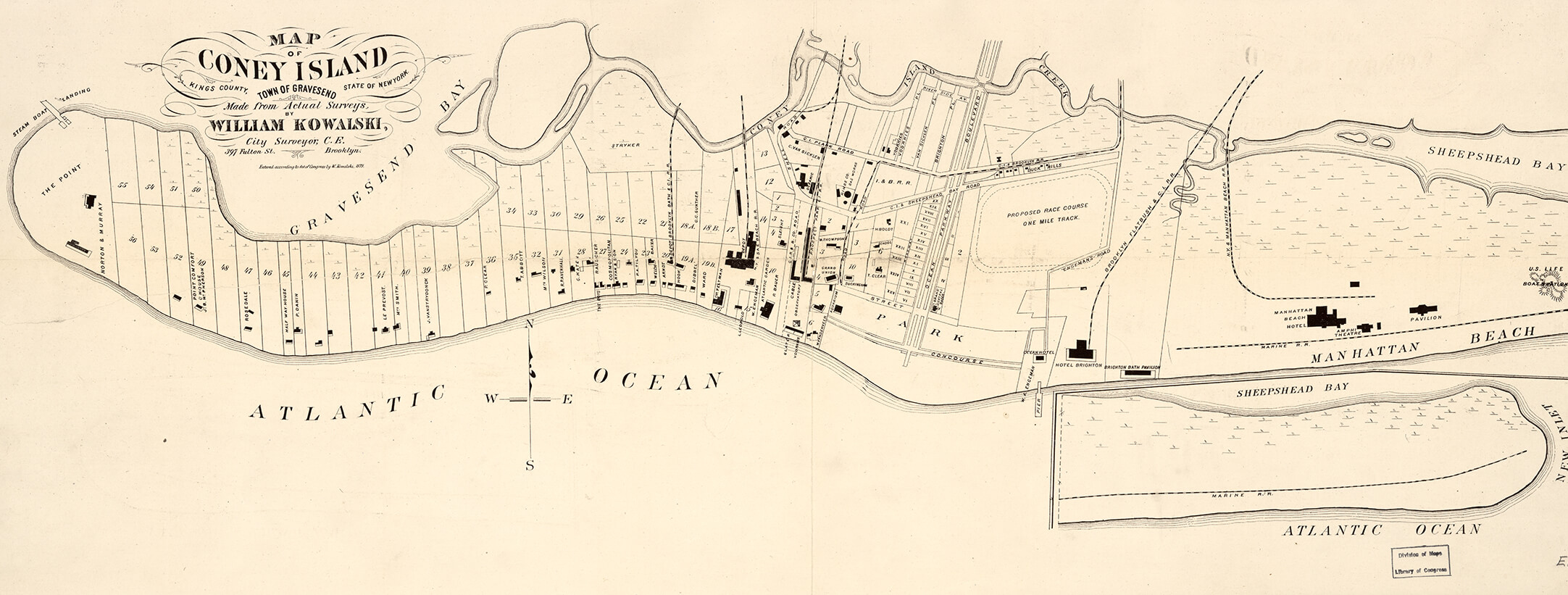
Coney Island in 1879. Map by William Kowalski via Library of Congress.
Coney Island became a part of Gravesend, the most remote town that made up Colonial-era Kings County. The island was back in the history books in 1776, when British troops made their beachhead there before marching to Gowanus to the Battle of Brooklyn, the first large battle of the Revolutionary War. After the war, the island retreated back to obscurity, enjoyed only by those who lived nearby.
All that would change in the mid-1800s.
It’s Always Been About the Beach
By the 1840s, a bridge had been built joining the island to the mainland, and a hotel called the Coney Island House was established. Many of America’s most famous people stayed there and enjoyed the sand and surf. By 1865, Peter Tilyou had established his Surf House, a restaurant, hotel and bathing emporium. Guests could not only wine, dine and stay overnight, they could rent bathing suits and dresses for men and women and frolic in the water.
By the beginning of the 1880s, a wider road reached Coney Island. Olmsted and Vaux’s Ocean Avenue was a clear path to the beach. New eating and bathing establishments were founded, with beer gardens, dancing pavilions and gaming rooms, as well as bath lockers and beachfront access. As the area became more popular, big-time hoteliers set about making Coney Island the East Coast Riviera.
The Era of the Grand Hotels
Coney Island, which includes the Brighton and Manhattan Beach areas, was ideal for development. Wall Street banker and railroad tycoon August Corbin built the first railroad to bring people to the beach, the New York and Manhattan Beach Railway. In 1877 he built a huge, elegant hotel called the Manhattan Beach Hotel. It had 258 elegant rooms, 700 feet of private ocean frontage, manicured lawns and an expansive verandah for beachside viewing. It also had several restaurants, a ballroom and other amenities. It was considered the most elegant hotel in the entire country. It was soon joined by the Brighton Beach Hotel, built a year later.
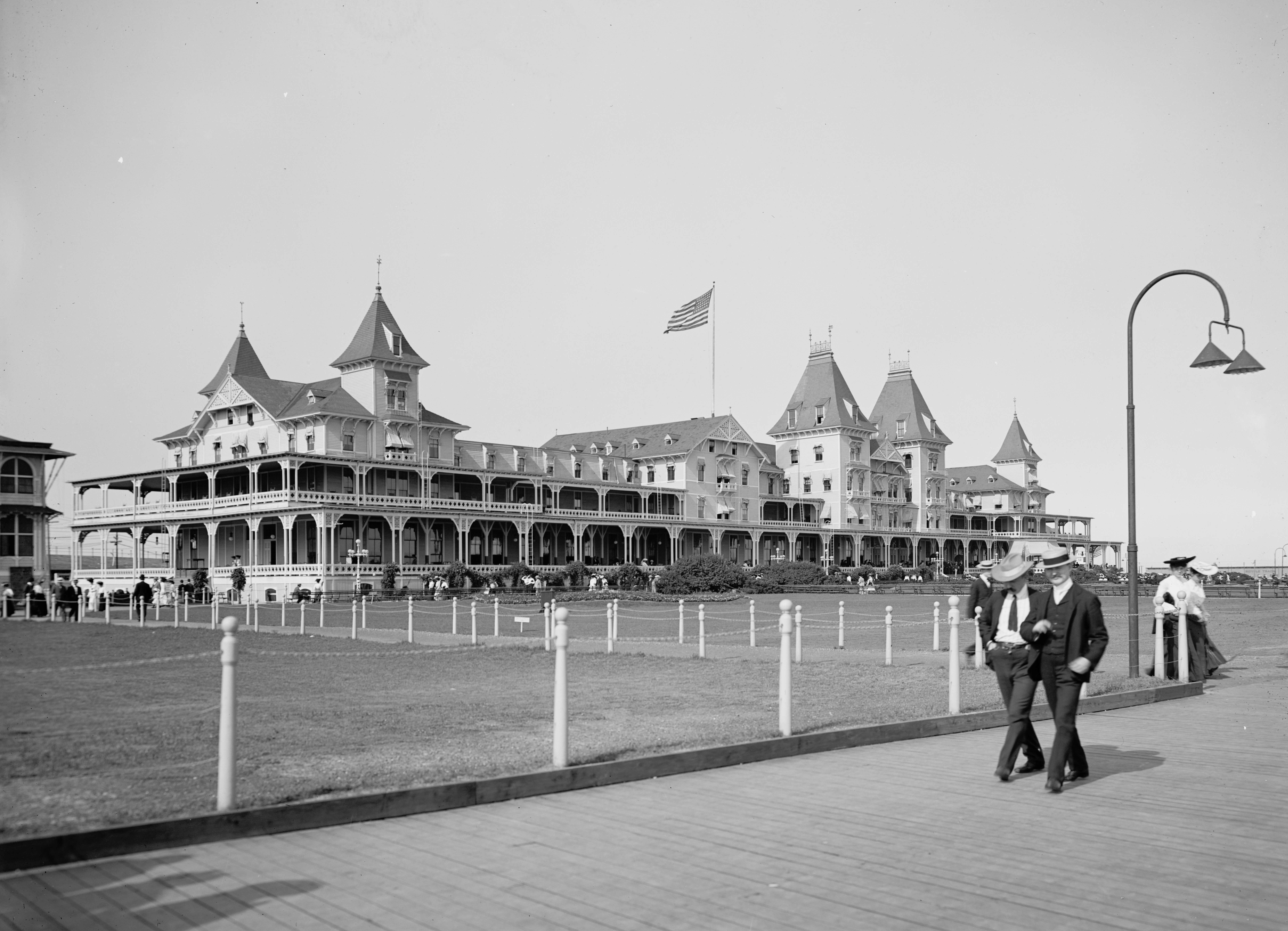
Brighton Beach Hotel, circa 1903, Detroit Publishing Company via the Library of Congress.
The Brighton Beach Hotel was bigger, fancier and swankier than its predecessor. Not to be undone, Corbin purchased more beachfront land and opened his Oriental Hotel, by far the most ornate and grand hotel on the beach. While this hotel one-upmanship was going on, a third developer, Andrew Culver, built his own railroad called the Prospect Park and Coney Island Railroad. It is remembered today as the Culver Line, now remaining as the Franklin Avenue Shuttle.
It brought people to his Culver Plaza on Coney Island: a huge pier with a tall iron tower. Visitors could take an elevator to the top for a bird’s eye view. Another Coney Island iron pier was established down the beach to receive visitors arriving by side-wheeler steamships, which left Manhattan in 20-minute intervals.
Coney Island was soon teeming with people.
The Heyday of the Hotels and Horses
Perhaps it would be more precise to say that Coney Island was teeming with well-off adults. All of the amenities were initially built to cater to those with leisure time and money. The three major hotels were exclusively for the rich. Exclusivity was fleeting, however. Smaller hotels and hotels without beach access soon sprang up for those of lesser means.
Racing down Ocean Parkway on horseback soon became a sport of its own. It was inevitable that someone finally decided to open a racetrack at the end of the route. The first was established by the owner of the Brighton Beach Hotel. In 1880, the Coney Island Jockey Club debuted, led by August Belmont, the father of the Belmont Stakes race. His club was soon the hangout of rich men like Diamond Jim Brady, W. K. Vanderbilt and Leonard Jerome, the grandfather of Winston Churchill. A third racetrack opened in Gravesend in 1886, making the Coney Island area the race track capital of the country.
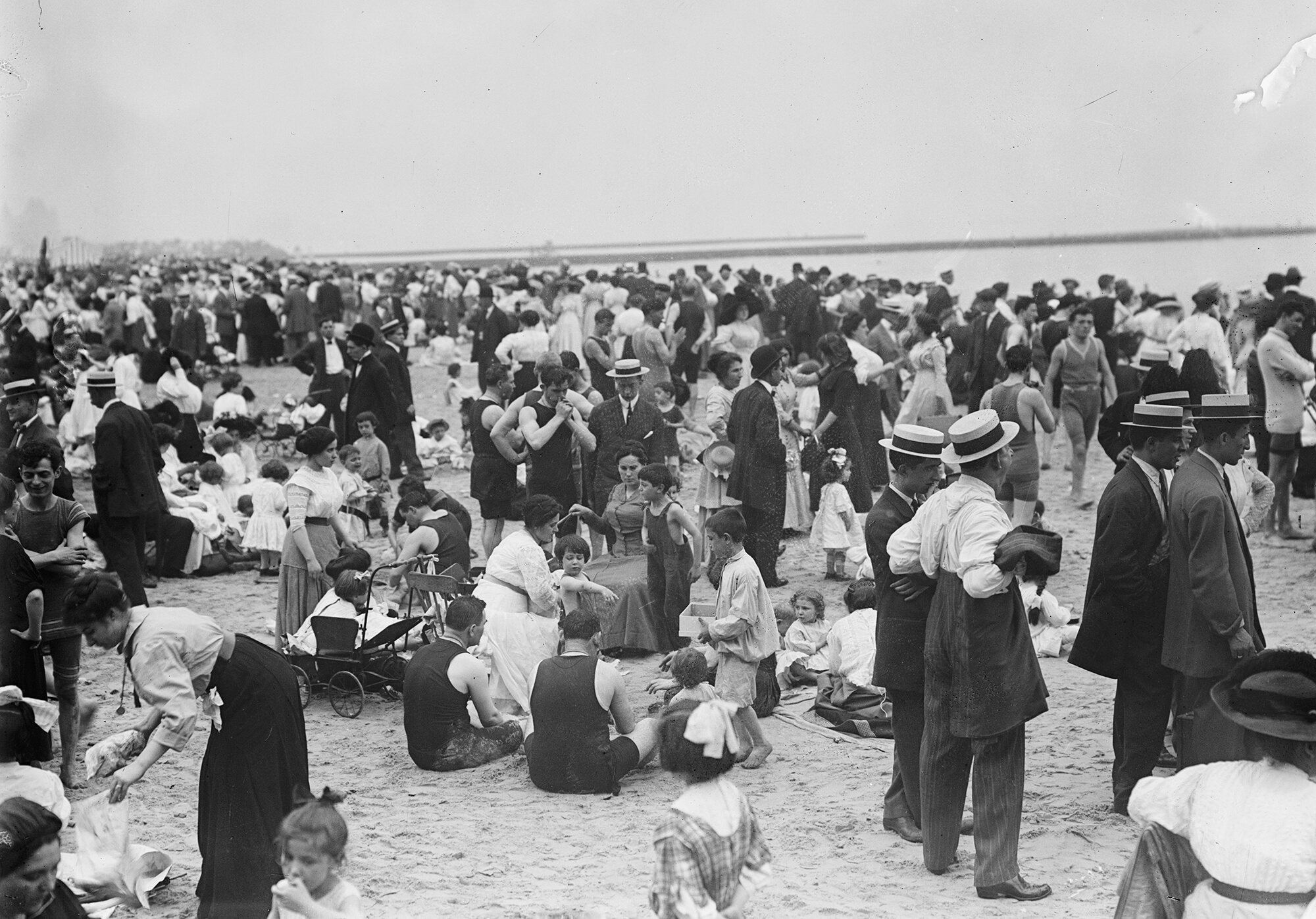
A packed Coney Island beach in the early 20th century. Photo by Bain News Service via Library of Congress.
With all of this came sleaze. Before long, two seedy red-light districts emerged. Men could watch girlie shows and drink and fight in the many bars, some of which were barely a plank across two boxes and a table or two. Prostitution, gambling, pickpocketing, drug use and fighting were rife in these districts. Yet only a short distance away, well-dressed men and women danced to John Philip Sousa’s band and the chime of crystal and silver mixed with laughter, music and fine food.
With easy access, more people began day tripping. Popular new restaurants such as Feltman’s were serving new, cheap foods like hot dogs in huge beer gardens. Coney was becoming more and more popular with the middle classes. Entrepreneurs began coming up with new ways to entertain all these people. In 1884, the first ride, a proto-roller coaster called the Switchback Railroad, opened. It was a big hit, and the beginning of Coney Island’s age of amusement.
The Golden Age of the Amusement Parks
The first Coney Island amusement park was called Sea Lion Park, and it opened in 1895. It was established by an extreme sports showman named Paul Boyton. He built the first Shoot the Chutes ride, soon to be a staple of every Coney Island amusement park. It was a flat bottomed boat that traveled down a steep watery incline with bumps that make the boat bounce riders up in their seats and splash them with water. When the boat got to the bottom, it was steered to a track that hauled the boat to the top to repeat the trip. It was a huge success.
Boyton’s park also featured the first looped roller coaster. Scarily, there were no harnesses or bar keeping riders inside when it went upside down. Centrifugal force, baby, that was it. In spite of these successes, Sea Lion Park closed in 1902.
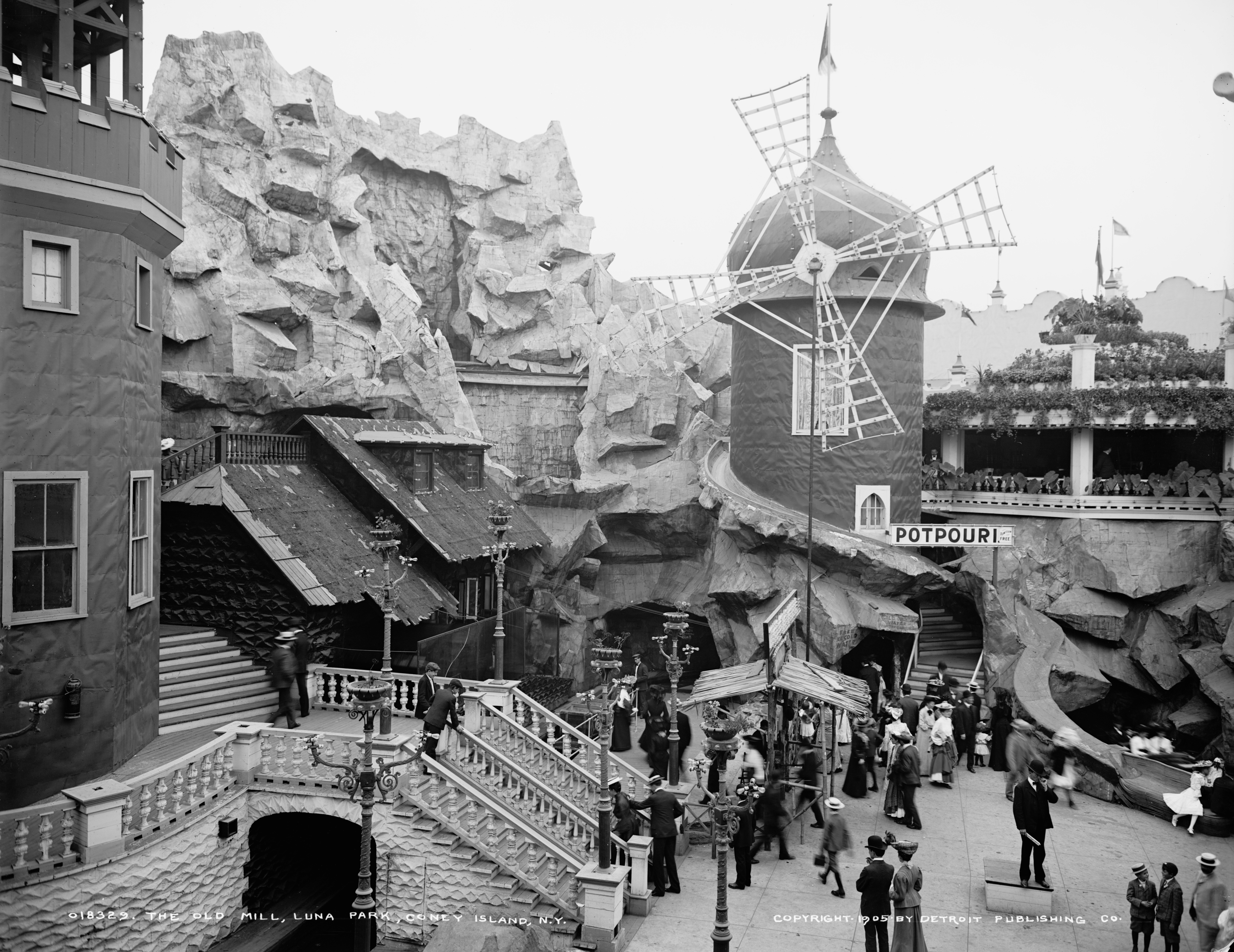
The Old Mill at Luna Park, circa 1905. Photo via Library of Congress.
George Tilyou, son of the operators of the Surf Hotel and the Surf Theater, had Coney Island in his blood. After attending the Chicago World’s Exhibition on his honeymoon in 1893, he fell in love with the first Ferris wheel. He leased some Coney Island land, bought a smaller Ferris wheel, lied and called it the largest one in the world, and opened for business. It was lit by thousands of incandescent lights and was a sellout. He followed that up by leasing a large piece of land around the wheel, creating Coney Island’s first large gated amusement park, Steeplechase Park.
Steeplechase was named for his iconic horse racing ride. Patrons rode metal horses that traveled along a long track that traversed the park, complete with dips and hills. Tilyou charged 25 cents to enter. Guests could ride all the rides and visit all the attractions for that admission. As it grew, he added more and more attractions.
Coney Island was not a playland for children. Some of the amusements eventually added children’s attractions like pony rides and carousels, but this was playland for grown-ups. People got dressed up to go there and spend a few hours away from the hot city streets. They enjoyed all of the attractions, including those that were slightly naughty. Tilyou’s rides blew air up women’s skirts, pressed strangers together, or featured other amusements that were deemed risqué to demure, middle-class ladies of all ages.
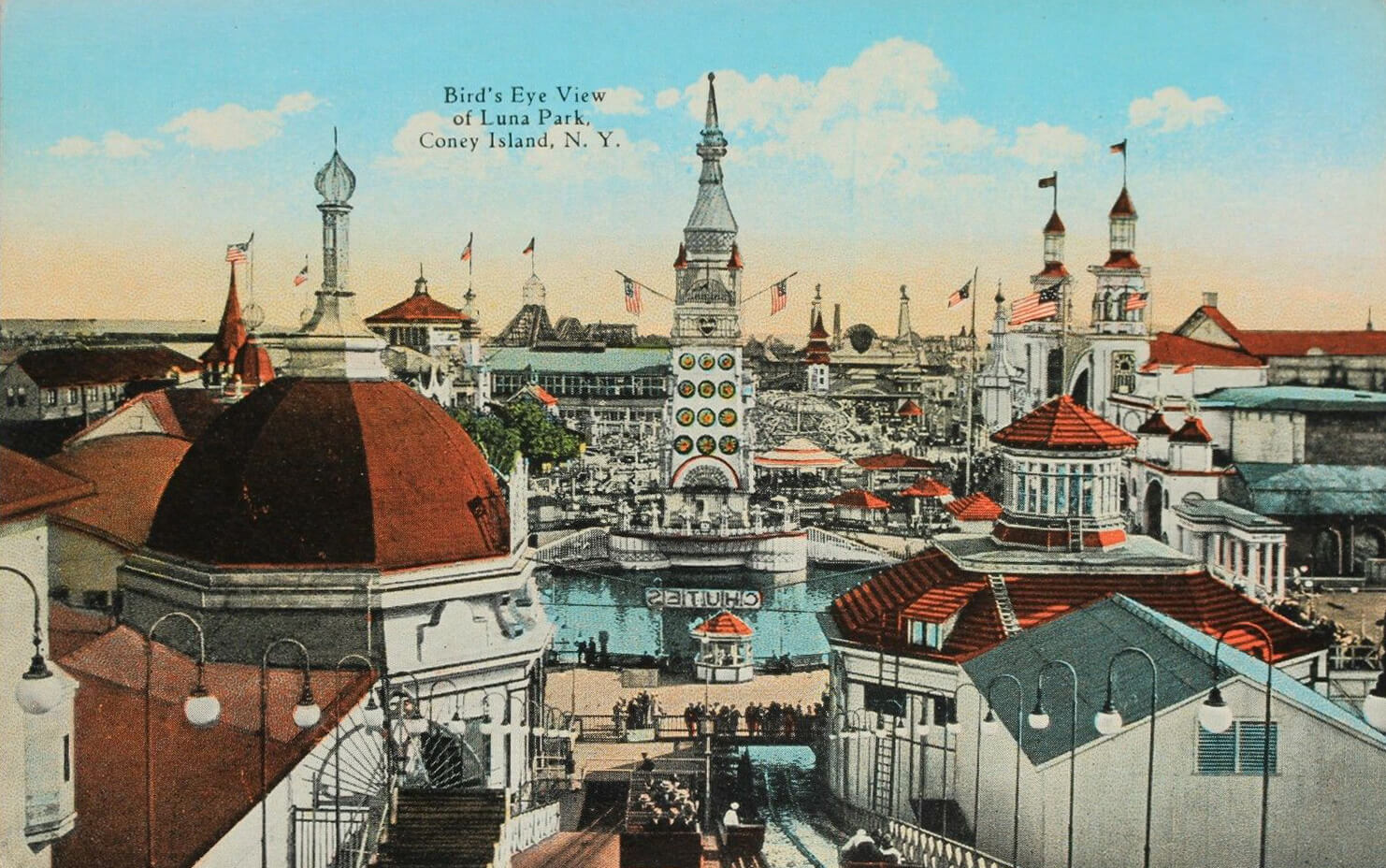
A bird’s eye view of Luna Park, Coney Island. Vintage postcard. Collection of Susan De Vries.
Steeplechase Park’s logo was a huge smiling face called the “Tillie.” He promised fun, some of it naughty, but harmless, as well as thrills and chills. The park was soon joined by two other large parks, as well as countless small operators who had one or two rides, or games of chance.
The second park was Luna Park. It opened in 1903 on the site of the old Sea Lion Park. Its operators kept the old park’s Shoot the Chutes and added other attractions. Wildly imaginative Middle Eastern-inspired architecture gave the park glowing minarets and towers, all lit with electric lights. Guest could wander through the city of Venice, go on a submarine ride or ride to the moon — the ride that gave the park its name.
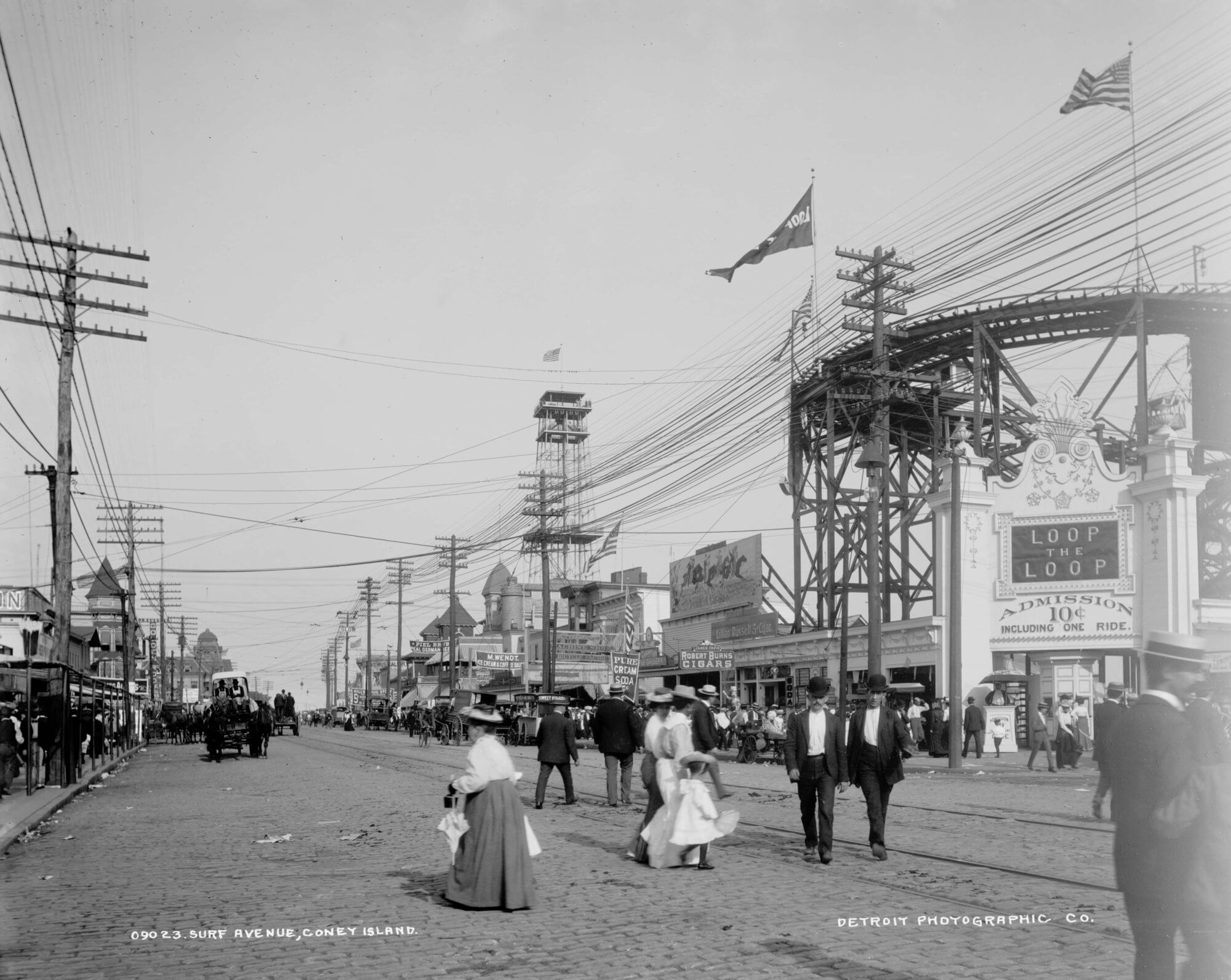
Surf Avenue, circa 1900-1906. Photo via Library of Congress.
Dreamland was the third park, owned by Brooklyn real estate developer William Reynolds. It was touted as more highbrow and uplifting than the other two, highlighted by a ride called “Creation” that showed the beginning of the universe and Judgement Day. He too had a Shoot the Chutes ride, a tall electrically lit observation tower, as well as many other attractions and architecture from around the world. It opened with great acclaim in 1904.
By the time Dreamland opened, the rich people had left Coney Island for more exclusivity out on Long Island and elsewhere. The horse racing tracks had closed, and the huge resort hotels either shuttered or burned down. In the early 20th century, the island was connected to the mainland with infill. Coney Island was now the popular everyman’s playland, available for the five cent price of a subway ticket.
Fire was a huge hazard in Coney Island. Both of the area’s red-light districts burned down. Steeplechase Park burned down in 1907. He immediately rebuilt. Dreamland burned down in a horrific conflagration in 1911. William Reynolds charged people admission to look at the ruins. Luna Park survived through a series of different owners until 1946. when it too burned down. The owners of the day also charged admission to view the damage.
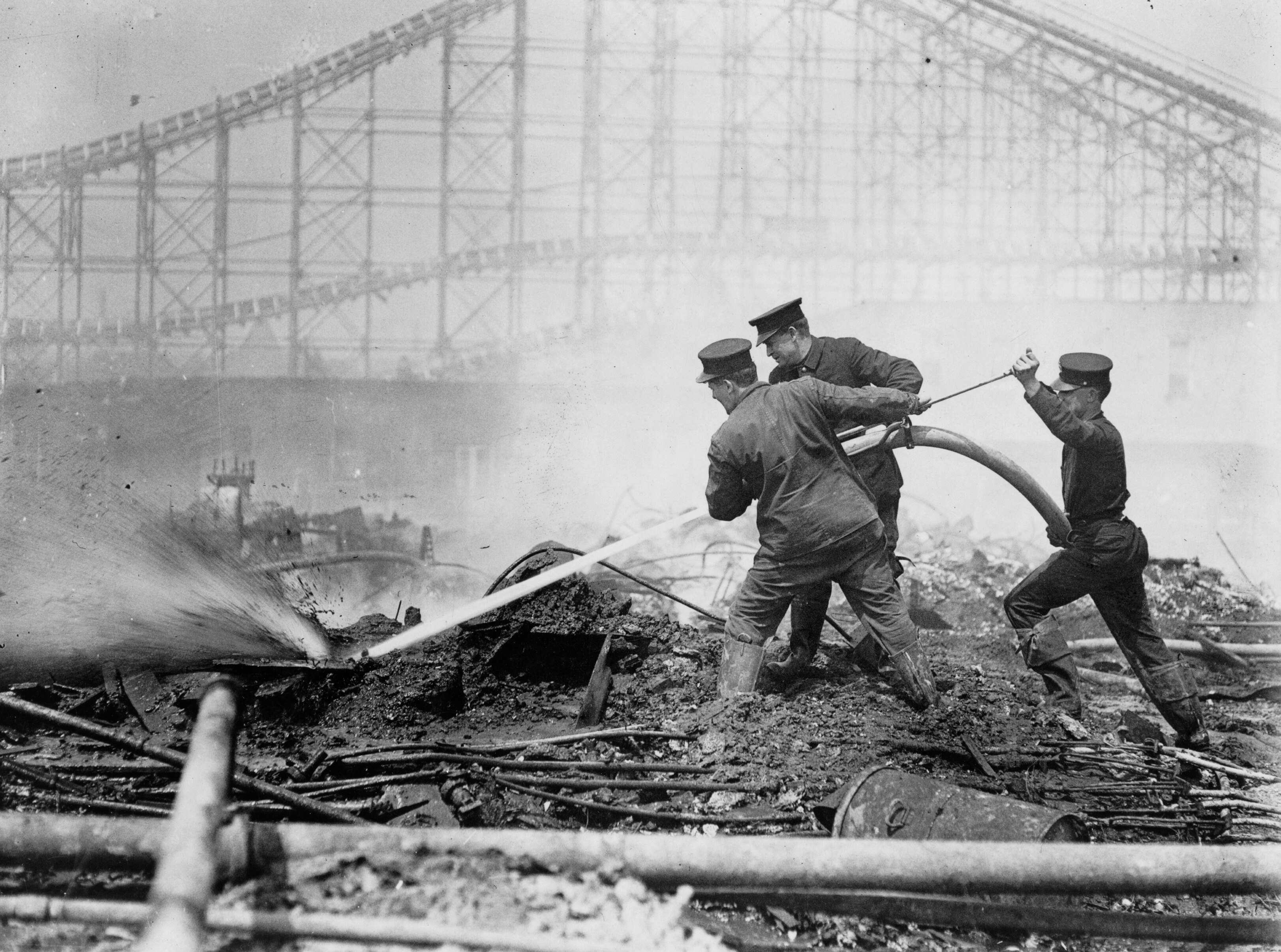
The Dreamland fire of 1911. Photo via Library of Congress.
This was almost the end of Coney Island. The area was rundown and tawdry. Its final glory days were immortalized as a World War II working class heaven for couples who would soon see the men off to war after one last ride on the Cyclone, the Parachute Drop or a walk along the famous boardwalk. Most of the attractions – the dancehalls, the rides, the gaming midways and the swimming pools — had either closed or were about to. A few carny families had owned the rides, the other amusements and the hotels. They were all dying out, and the grandchildren of the founders were not interested in the businesses.
New owners were only in it for the money, and did little to improve anything or even keep the equipment in good order. By the beginning of the 1960s, there wasn’t much left. Coney Island became known more for gang fights, general hooliganism and crime. Robert Moses wanted to tear everything down to build high rise apartment projects.
The land that once held Steeplechase Park was sold to Fred Trump, who flipped it to the city for $4 million. They eventually built KeySpan Park ballfield, now MCU Park, also home to the Brooklyn Wall of Remembrance. Dreamland’s acres now house the New York Aquarium. The original Luna Park land is now a high-rise apartment complex still called Luna Park.
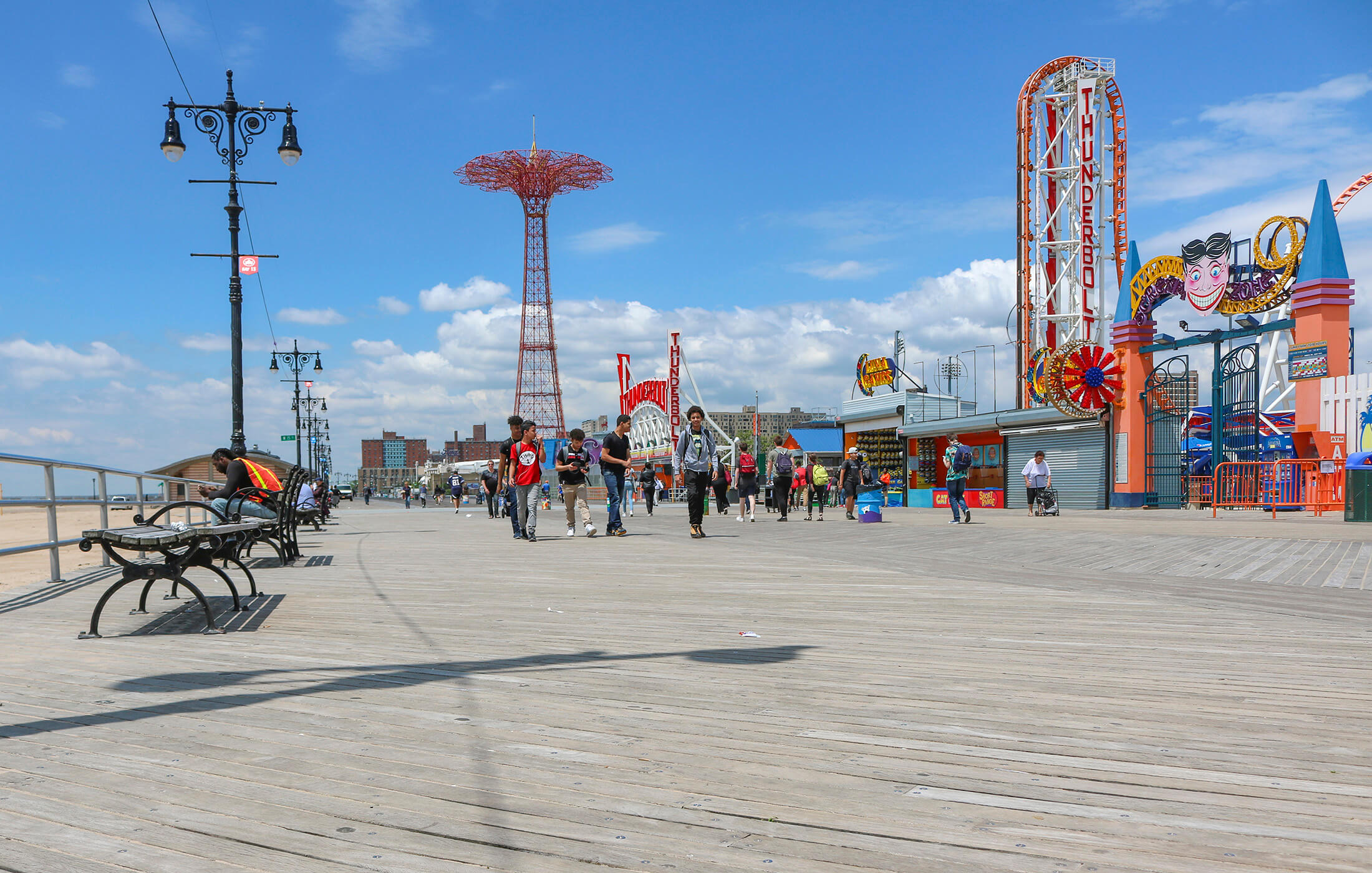
The boardwalk in 2018. Photo by Susan De Vries.
Astroland, an amusement park established in 1962 as a futuristic theme park, was the last of the Coney Island parks. It was home to the Cyclone, Coney Island’s famous roller coaster, a ride that had outlived just about everything. In 2006, the owner sold the amusement park to Thor Equities, but negotiated to keep the park going. It lasted only another two years.
The park was sold to Zampara/Central Amusement International, which built the new Luna Park on the site. The park has done well, coinciding with a new outside interest in all things Brooklyn. The city announced an expansion of the new Luna Park this last year. Soon new rides will amuse adults and children alike.
The Ford Amphitheater opened on the boardwalk in 2016, followed a year later by the restored and landmarked Childs Restaurant. The boardwalk was landmarked in 2018. Coney Island is once more part of “Brooklyn cool.”
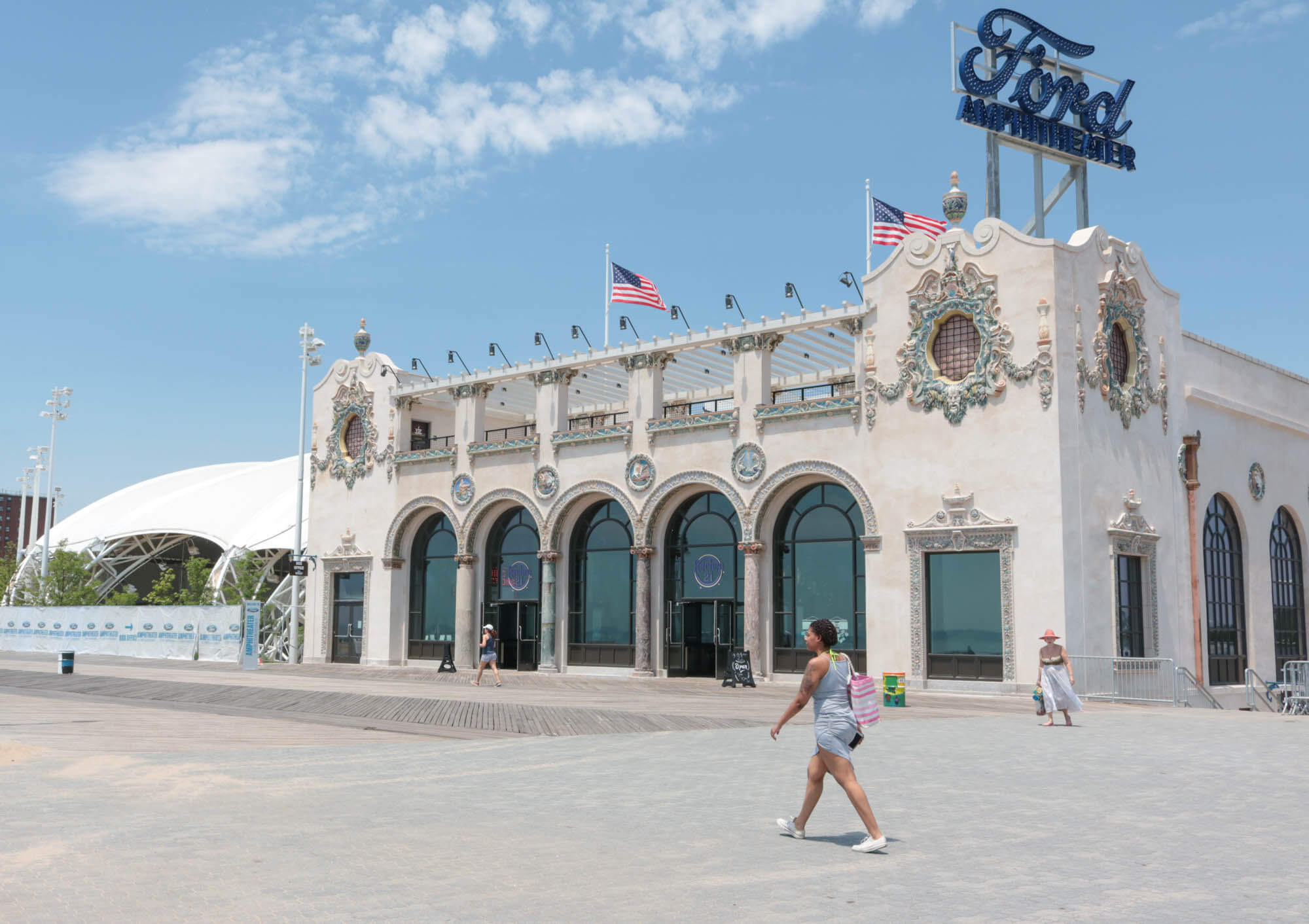
The restored Childs Restaurant in 2017. Photo by Susan De Vries.
Coney Island has seen the Canarsie hunting rabbits, Henry Hudson, wealthy day-trippers and resort-goers, as well as the screaming hordes of people on the rides or baking in the sun on the People’s Riviera. Whether walking along the boardwalk or grabbing a hot dog dripping with mustard and sauerkraut at Nathan’s Famous, these are the sounds and smells of the ocean, the beach and the shore.
There are few places in Brooklyn as storied as Coney Island. You can’t call yourself a Brooklynite if you have never been there. Go. Before it becomes Vegas on the Atlantic, a gated community or something other than a place of history, memories and the eternal sea.
Written by Suzanne Spellen (aka Montrose Morris) on July 15, 2019, for Brownstoner Newsletter of Brooklyn, New York.
Week One: Women’s Suffrage Movement




